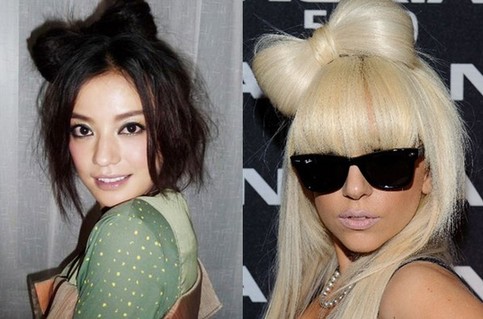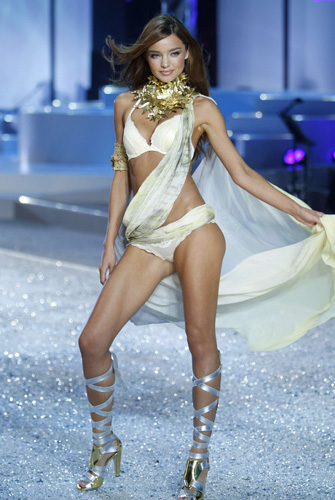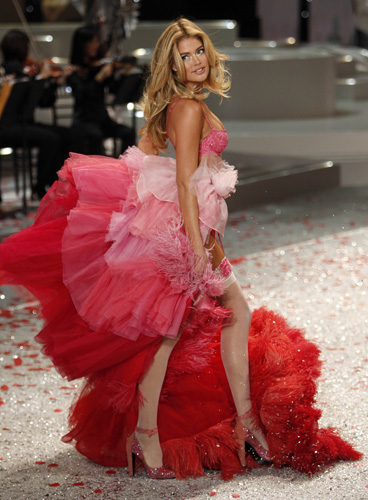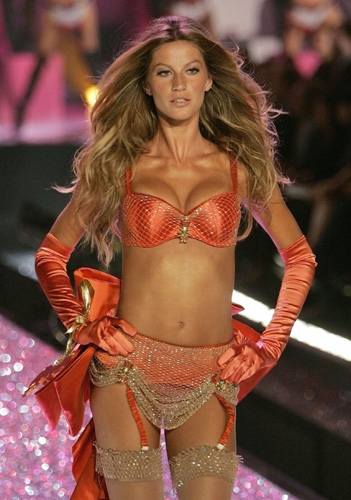 Romek Gelard Gello
Romek Gelard Gello Mc kenneth Licon
Mc kenneth Licon Anna Le
Anna Le Samantha Mariko
Samantha Mariko Robbie W
Robbie W
Intertextile Shanghai Home Textiles, or China International Trade Fair for Home Textiles & Accessories is to open in Shanghai New International Expo Centre in Shanghai on 24-26 August 2010.
With ten exhibition halls and over 950 home textile suppliers exhibiting from 24 countries and regions, Intertextile Shanghai Home Textiles is the ideal destination to hold the first international home textiles and interior trend zone. The debut forum will be located in Hall W2 at the Shanghai New International Expo Centre from 24 ?C 26 August, 2010.
World-class trend forecasters from Italy, Ms Ornella Bignami of Elementi Moda, and Mr Kai Chow of Doneger Creative Services, from the US, will direct the trend zone, providing attendees new inspirations for their 2011/2012 collections with exhibitors?? fabrics and home products.
Show participants will find an extensive range of home textile design concepts at the Designer??s Studio in Hall W1. This special area will gather 23 home fashion designers from France, Italy, Japan, Korea and UK to present the best designs, prints and patterns at their country.
Visitors can also gain inspirations from traditional Chinese, European and Southeast Asian textile weaving patterns and techniques at the Cultural Heritage Zone located in Hall E5, demonstrating the synergy effects of eastern and western traditional textile cultures.
Intertextile Shanghai Home Textiles is organised by Messe Frankfurt (HK) Ltd.; the Sub-Council of Textile Industry, CCPIT; and China Home Textile Association (CHTA).
With the recovery of global economy, the knitting industry will be facing new development. Knitting enterprises will be getting more space for development from the thriving domestic and foreign markets. Under the fierce competition, who seizes the opportunity, can occupy the market.
2010 China International Knitting Trade Fair, a splendid sourcing trading platform with excellent service, brings you infinite business chances than you can image.
Yarn Expo
Yarn Expo Autumn, or China International Trade Fair for Fibres and Yarns, opens next week on 24 August 2010 for three days at the Shanghai New International Expo Centre in Hall W4. Held concurrently with Intertextile Shanghai Home Textiles and the China International Knitting Fair, gives attendees the ultimate one-stop business platform for all of their sourcing needs.
Over 90 suppliers are confirmed to showcase their collections of yarns and fibres ranging from natural fibres made from cotton, wool silk and linen/ramie to regenerated and synthetic man-made fibres and yarns as well as fancy blended yarns. Countries and regions represented include China, Hong Kong China, India, Pakistan, Singapore and Turkey plus a new country highlight from Thailand.
For the first time, exhibitors from Thailand will showcase man-made fancy yarns, meanwhile several India and Pakistan based suppliers will offer their competitive cotton yarn collections.
Besides international representation, many top Chinese suppliers will be on-site. Famous brands include:
- Shandong Ruyi Group, displaying all kinds of cotton, man made and fibres and yarns
- Shandong Hongye Textile Co & China Resources Textiles Holdings Co displaying high count yarns
- Inner Mongolia Erdos Donghua Cashmere Worsted Textile Co displaying wool products
- Shanghai Galaxy Metallic Yarn Co displaying metallic yarns
- Fulida Group Hangzhou Import & Export Co displaying viscose yarns and dope dyed polyester
- ZheJiang Lida Modern Textile Co displaying fancy yarns
- Hunan Huangsheng Dongting Textile Co displaying linen/ramie
To further complement the colourful range on offer and for easy navigation at the fair, a special Viscose fibre zone, covering 90sqm, will group seven viscose manufacturers from China.
Cross-strait Textile & Fiber Industries Cooperation and Communication Conference was hold in Taibei in August 10th, with the joint work of Taiwan Textile Research Institute and China National Textile & Apparel Council. The two sides signed seven agreements in this event, including the construction of communicatin platform, cooperation system, linking transnationals and layout globally, as well as promoting industry bussiness opportunities.
During the one-day conference, the two sides agreed to promote the R&D in technical textiles and function textiles, based on the complementary advantages; to meet the requirements on environment protection, energy-saving, low carbon production and other social responsibiliites, the two sides will promote the communication in technology, informaiton and product, as well as relative plans.
The Mainland has became the bigest import and export market, and investing market for Taiwan textile and apparel industry. According to the 2009 statistics from Taiwan, the import from mainland accounted for 34% of the total, or 740 million USD. While the export, including to Hong Kong, reached 3.3 billion USD, accounting for 36^. Up to the end of last year, Taiwan had approved 2378 investment cases to mainland in textile and apparel business, involving 2.7 billion USD, accounting for 50% of the total overseas investment in this industry.
About 350 industry professionals, experts, scholars and officials attended this conference, 270 from Taiwan and 80 from mainland. This conference is expected to hold in mainland next year. This event is one of the ??Bridge?? programs, supported by Taiwan economy department.
China's pace of industrialization has gone faster than Japan's and Chinese products are moving up the value chain, Ernest & Young's Global Chairman and CEO James Turley said in an interview via e-mail with Xinhua.
"When I was a boy in the United States, 'Made in Japan' meant inexpensive, low-value-added manufactured goods. But by the time my son was born, 'Made in Japan' meant some of the very best, most high-tech manufactured goods in the world. That happened in a generation. China's pace of industrialization, and of moving up the value chain, has gone even faster than Japan's," he said.
"Made in China" Goes Further
The head of E&Y, one of the biggest four auditors, said "Made in China" still takes time to rise from low end to high end in the global value chain, but there are Chinese companies today that can compete with anyone on manufacturing skill and there are more and more of them each year.
China's GDP has surpassed Japan as the second biggest economy in the world, and "Made in China" is already all around the world, but the low value-added products, the lack of world-class brands and technology are still a problem for the country. [China 'overtakes Japan in economic prowess']
Meanwhile, Chinese enterprises' exports and investment abroad have encountered trade barriers and protectionism in recent years.
Despite Geely Auto's successful acquisition of Volvo, there were a number of failed overseas takeovers by Chinese energy resources giants and Huawei, Chinese leading telecom equipments provider, in the United States.
The Chinese government had previously advertised overseas "Made in China, Made with the World" to share its ideology of win-win game with other countries.
Turley said the way that China and other developing and emerging markets are producing their own world-class companies is one of the great stories of the past decade, and they will have more and more in the coming years.
"Geely, for example, was the winner of our China 'Entrepreneur Of The Year' competition in 2009 and is a great example of a company that is going places."
"Politics may sometimes be a factor in cross-border acquisitions, no matter what border is being crossed or who's crossing it. As Chinese firms buy more companies overseas, I'm sure they will become more experienced in addressing that factor. But I don't think it has become a 'major risk',"said Turley.
E&Y has been operating in China's Hong Kong for nearly 40 years, and established its first office in Chinese mainland 30 years ago. It has currently over 9,000 staff members in China. To expand its business in China, it just inaugurated a new office in China's tallest building -- Shanghai World Financial Center this month.
World Economy Slowdown, Business Risks
Commenting on the situation of the world economy, the professional of E&Y said a recovery is on the way, but that recovery is happening at very different speeds.
"I agree with those people who have described it as a 'LUV' recovery -- it's L-shaped for Western Europe, it's U-shaped for North America, and it's V-shaped for China and other developing and emerging markets," Turley said.
"But there are still risks that recovery could go into reverse in places. Even though that's a 'macro' risk, companies can still try to mitigate it by ensuring strong risk management, flexible cash management and sustaining cost-cutting measures. Especially if the credit markets tighten up again," he added.
In the second quarter of 2010, substantial changes surged in the world economy. Recently various macroeconomic indicators have shown signs of slower resurrection both in the developed and the emerging economies.
E&Y thinks in this changing macro environment, the other important risk for enterprises to focus on is about corporate governance.
"Every company needs to challenge its system of corporate governance to make sure it's truly up to the job. That means it contains the right checks and balances, puts focus onto the most important risks that company faces, and creates a culture that encourages people to raise their hands, ask questions and challenge the status quo," said Turley.
The auditor's chief mentioned one more risk for some companies, "the risk of being too cautious or conservative in business strategy at a time when recovery is upon us."
Regulation, Responsibility And Green Premium
The international regulatory environment change was listed as the No 1 challenge in E&Y's latest Report of The Top 10 Risks for business. Does it mean that the companies will cost more to comply with the current global regulatory trends?
Turley said he agrees that good regulation is a very important aspect of financial markets and other areas of business, and that good regulation can mitigate system risks.
"Identifying regulation as a challenge for business globally is not to say that the respondents to the survey think regulation is a problem. What they're saying is that business everywhere will need to focus more attention on the changing regulatory environment post-crisis, and that it is vital that regulation be coordinated across geographies to ensure a lack of redundancy and a lack of gaps," Turley said.
Turley also said, in his personal view, being a responsible corporation means what you do every day is to make a "positive difference." He is convinced that enterprises "will do well by doing good."
In terms of a green premium, high price/earnings (PE) ratio that eco-friendly public companies enjoy in capital markets, he said a lot of research has shown that consumers are willing to pay for products that are more environmentally friendly.
Besides, companies everywhere are increasingly using their environmental credentials as a source of competitive advantage.
"As both regulation and public scrutiny increases, it's only logical that capital markets will look at organizations' environmental impacts and reward those that work to mitigate them, " said Turley.

Video adress: http://www.chinadaily.com.cn/video/2010-08/23/content_11188752.htm
Czech design is being presented itself at EXPO Shanghai during the Czech Fashion Week, featuring runway shows by five Czech fashion designers who created original collections with a common theme - Memory. Monika Drápalová, Pavel Ivančic, Klára Nademlýnská, Denisa Nová and Liběna Rochová will, in addition to the runway show, display their designs at a subsequent exhibition at the most prestigious address of world fashion labels - Bund 18 – in the centre of Shanghai.
SHANGHAI - The world's fashion capitals can no longer feel secure about their dominance after Asian metropolises Hong Kong and Shanghai sashayed into prominence, this year's Top Global Fashion Capitals reveals.
The list, compiled by American non-profit group Global Language Monitor, puts New York back on top as the world's top fashion capital, reclaiming its spot from Milan this year.
But the annual poll also showed the top fashion cities seeing competition from China, with Hong Kong in second place and Shanghai 12th.
Topping the list are New York, Hong Kong, London, Paris and Los Angeles. Milan, Sydney, Miami, Barcelona and Madrid followed.
Shanghai even beat out Tokyo (14th).
"This year's list of the Top Fashion Capitals shows the global fashion industry remains in flux, with the relative decline of some of the previously leading players and formerly regional players emerging as significant new influences," said Rebecca Payack, the Manhattan-based fashion correspondent for Global Language Monitor.
"The Orient is definitely where Westerners wish to check out about fashion," said Chinese fashion critic Lin Jian.
Ji Cheng, a Shanghai-based designer who flies frequently to the world's fashion centers for shows, sees more energy in the upcoming fashion capital of Shanghai.
"You have to admit Hong Kong is a more matured fashion destination - at least 20 to 30 years more advanced than Shanghai, but there's a gap between the well-established designers like Vivian Tam who are now 53 and the new generation of Hong Kong designers," she said.
"As for Shanghai, which I see more as the gathering place for young freelancers and newcomers, a growing number of designers are making the difference," she said.
Professor Bian Xiangyang from Shanghai-based Donghua University caught a hint of economic influence on the fashion list by saying "international influence is a necessary element to make sure you're on the list".
"Because of its depressing performance from an economic perspective in recent years, Japan doesn't have the same impact it used to have. While with Expo 2010 Shanghai on the horizon, Shanghai caught up," he said.
The ranking of Top Global Fashion Capitals 2010 tracked the frequency of words and phrases in print and electronic media, on the Internet and throughout the blogsphere. But this way of collecting data and making the list is challenged by mainstream authority.
"Couch potatoes with no fashion experience could say something on the Internet nowadays, and I highly doubt the credibility of the list because of it," said Bao Mingxin, another professor from Donghua University.
"I'd suggest making the list according to the coverage of luxury brands in each city across the world," said Lin.
The Lady Gaga craze has swept across the globe, her signature style sets off widespread imitations. Lady Gaga has never made her appearance in China, but there are several celebrity followers here.

Chinese actress Zhao Wei shoots a photo spread featuring Lady Gaga's hairstyle.

Hong Kong singer Joey Yung shoots a photo spread for her new album featuring 'fierce' style.

Chinese singer Sun Yue refines her dressing style which to great extent imitates the new fashion icon Lady Gaga.
Big news! Newly-married supermodel of Victoria’s Secret Miranda Kerr confirmed that she is pregnant for 4 months. Will she still be charming even with a baby bump?
Don't worry! Some other hot supermodels have already set good examples for her. They all proved that pregnant women also could be fascinating.
1. Miranda Kerr

2. Doutzen Kroes

3. Gisele Bundchen

A special underwater show was held in Seoul Lotte Department Store on 22nd, August.
Creations of Korean designer Ms Park Sul-nyeo were displayed by several models who are water gymnastic players.




This latest just-style report is a think piece about the future of the apparel industry. It is intended to encourage apparel industry executives to consider what is going to shape future products, markets and processes in the apparel industry.
In order to do this, forecasts have been made about future trends in what is, by definition, a very fast and continuously changing industry, one which feeds and lives on change. Areas covered include: future merchandise trends; market and distribution evolution; the supply chain; future sourcing and production; political and government influences; ethics, Fairtrade and CSR; technology and systems.
Use this report to analyse the effect the downturn has had on the apparel industry and identify the likely trends out to 2016.
Offering historic and forecast trends for regional markets, sales by product group, by distribution type, wholesale market values, and production values, this report is an essential guide for you to assess what landscape your business will likely move into over the next seven years.
Chapter 1 Introduction and hypothesis
This chapter sets the scene for how the apparel industry has evolved, commenting upon fully automated clothing production and parallels drawn between other manufacturing industries' approaches to automation and how this migrated to apparel.
When this is conjoined with the pressure of fast fashion retailing and technological advances in the supply chain, it becomes both tempting and plausible to believe in an apparel industry that supplies small quantities locally very quickly.
So, why is this not the norm in today's apparel manufacturing industry? Why are there still very large, small component based factories producing very large orders in very large batches of standardised product? This report addresses these issues. It also forecasts the trends in the apparel industry and discusses the issues that will shape it.
Chapter 2 Forecast methodology discusses how just-style arrived at the report's forecast (and historic) numbers for Market-, Product-, Distribution-, Industry- and Production-trends.
Chapters 3 through to Chapter 8 contain trend forecasts for the above sectors of the apparel industry. Each chapter contains market value from 2007 to 2016, together with scenario forecasts with...
For more information please click on:
http://www.researchandmarkets.com/product/9034b6/tomorrows_apparel_industry_products_market
Title Index:
Chapter 1 Introduction and hypothesis
- Demassification
- Fully automated clothing production
- The second Toyota system
- Hypothesis
Chapter 2 Forecast methodology
- Caution
- Definition of apparel
- Methodology for market forecasts
- Methodology for the other forecasts
Chapter 3 The market before and during the current downturn
- The market in the recent past
- The market in the current downturn
- The market: likely future scenarios
Chapter 4 Recent merchandise trends and product changes
- The product mix in the recent past
- The product mix in the current downturn
- The product mix: likely future scenarios
Chapter 5 Marketing and distribution evolution, before and during the current downturn
- Distribution in the recent past
- Distribution in the current downturn
- Distribution: likely future scenarios
Chapter 6 The supply chain in the apparel industry
- Consumers
- Retailers
- Brands and wholesalers
- Branded and external manufacturers
- Fabric and other material suppliers
- Value added in the supply chain
Chapter 7 The industry before and during the current downturn
- Wholesale values
- The industry in the recent past
- The industry in the current downturn
- The industry: likely future scenarios
Chapter 8 Sourcing and production before and during the current downturn
- Sourcing and production in the recent past
- Sourcing and production in the current downturn
- The industry: likely future scenarios
Chapter 9 Tomorrow's apparel industry: the arguments
- The status of the apparel industry worldwide in numbers
Chapter 10 Political and government influences
- The multi-fibre agreement
- Other government interventions
- DR-CAFTA
- US textile industry versus China
- EU directive on clothing recycling
- Australian federal funding for TCF
Chapter 11 Ethics, Fairtrade and corporate social responsibility
- The case for and against
- Low wages in Sri Lanka
- Dumping chemical waste in Africa
- Educating the consumer in environmental issues
- Primark goes ethical
- Conclusion on its impact
Chapter 12 Technology and systems
- Information exchange (EDI)
- Factory layout
- The progressive bundle unit
- Team working
- CAD/CAM technology
- Product lifecycle management (PLM)
- Supply chain management
Chapter 13 Blue skies thinking: likely and unlikely future scenarios for the apparel industry
- Personalisation
- Rejection of the throw-away society
- Smart clothes
- Electronics and textiles
- Individual deliveries and the decline of shops
- Local manufacturing
- Changes caused by government legislation
- Totally new fibres and fabrics
- Blue-sky conclusion
List of Figures:
Figure 1: The supply chain in the apparel industry from producer to consumer
List of Tables:
Table 1: Retail value of the global apparel market by region, 2007-2016 (US$bn)
Table 2: Retail value of the global apparel market by clothing type, 2007-2016 (US$bn)
Table 3: Retail value of the global apparel market by distribution channel, 2007-2016 (US$bn)
Table 4: Wholesale value of the global apparel market by region, 2007-2016 (US$bn)
Table 5: Production value of the global apparel market by region, 2007-2016 (US$bn)
Table 6: Global apparel production and distribution by region where made, 2010 (US$bn, % share)
Pricing:
Electronic (Single User) : EUR 774
Electronic (Site License) : EUR 2321
Ordering - Three easy ways to place your order:
1] Order online at http://www.researchandmarkets.com/product/9034b6/tomorrows_apparel_industry_products_market
2] Order by fax: Print an Order form from http://www.researchandmarkets.com/product/9034b6/tomorrows_apparel_industry_products_market and Fax to +353 1 4100 980
3] Order by mail: Print an Order form from http://www.researchandmarkets.com/product/9034b6/tomorrows_apparel_industry_products_market and post to Research and Markets Ltd. Guinness Center, Taylors Lane, Dublin 8. Ireland.
Related Titles also available from Research and Markets:
The Future of Indian Fashion - 2011 and Beyond: Trend Research, Analysis & Forecasting in the Apparel Sector -
http://www.researchandmarkets.com/product/9034b6/the_future_of_indian_fashion_2011_and_beyon
Global Apparel Markets: Product Developments And Innovations, 1st Quarter 2010 -
http://www.researchandmarkets.com/product/9034b6/global_apparel_markets_product_developments
Analyzing the Chinese Apparel Industry -
http://www.researchandmarkets.com/product/9034b6/analyzing_the_chinese_apparel_industry
2010-2011 Mass Merchandiser's & Off-Price Apparel Buyers -
http://www.researchandmarkets.com/product/9034b6/20102011_mass_merchandisers_offprice_app
Indonesia's Ministry of Trade will enforce new rules mandating the inclusion of labels on certain kinds of import goods to provide consumers with accurate information. Effective September 1, 2010, manufacturers or importers of regulated goods to be traded in the Indonesia market will be required to include this labeling in the Indonesian language, said a bulletin on Bureau Veritas's website.
According to the bulletin, specific goods in question include four categories: household electronics (46 items); building construction materials (8 items); motor vehicle materials (spare parts and others) (24 items); and other commodities (e.g., footwear, leather products, toys, apparel, etc.) (25 items).
Contents required to be included for all covered products are name and/or brand name; name and address of manufacturer; name and address of importer; and country of origin. Additional information may be necessary depending on the product type. All information must be written in the Indonesian language. Arabic digits and Latin letters are allowed if there are no proper equivalent Indonesian terms.
Label information must be submitted for approval to the Director of Supervision of Available Goods and Services. A certificate will be issued within five working days after receipt of the sample. Manufactures or importers of regulated goods can proceed with business upon receipt of the certificate.
The new regulation will take effect on September 1, 2010 for new products and for goods that have been circulating on the market before the new regulation applied, 18 months transitional period will be allowed.